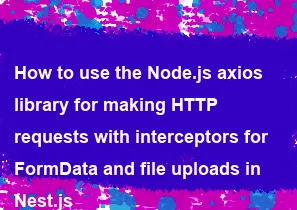How to use the Node.js axios library for making HTTP requests with interceptors for FormData and file uploads in Nest.js

To use the Axios library for making HTTP requests with interceptors for FormData and file uploads in Nest.js, you'll need to set up Axios within your Nest.js project and define the interceptors accordingly. Here's a step-by-step guide to accomplish this:
- Install Axios in your Nest.js project if you haven't already done so:
bashnpm install axios
- Import the Axios module and define your interceptor functions:
typescript// src/common/axios.interceptor.ts
import axios, { AxiosRequestConfig, AxiosResponse } from 'axios';
// Function to intercept FormData requests
export const formDataInterceptor = () => {
axios.interceptors.request.use(
(config: AxiosRequestConfig) => {
if (config.data instanceof FormData) {
config.headers['Content-Type'] = 'multipart/form-data';
}
return config;
},
(error) => {
return Promise.reject(error);
}
);
};
// Function to intercept file uploads
export const fileUploadInterceptor = () => {
axios.interceptors.request.use(
(config: AxiosRequestConfig) => {
if (config.method === 'post' || config.method === 'put') {
if (config.data && config.data.file) {
// Assuming 'file' is the key for the file in the FormData
const formData = new FormData();
formData.append('file', config.data.file);
config.data = formData;
}
}
return config;
},
(error) => {
return Promise.reject(error);
}
);
};
- Register these interceptors in your Nest.js module:
typescript// src/common/axios.module.ts
import { Module } from '@nestjs/common';
import { formDataInterceptor, fileUploadInterceptor } from './axios.interceptor';
@Module({
providers: [],
exports: [],
})
export class AxiosModule {
constructor() {
// Register your interceptors when this module is instantiated
formDataInterceptor();
fileUploadInterceptor();
}
}
- Import and use the AxiosModule in your main application module:
typescript// src/app.module.ts
import { Module } from '@nestjs/common';
import { AxiosModule } from './common/axios.module';
@Module({
imports: [AxiosModule],
controllers: [],
providers: [],
})
export class AppModule {}
- Now, you can use Axios for making HTTP requests with FormData and file uploads in your Nest.js services:
typescript// src/your-service.service.ts
import { Injectable } from '@nestjs/common';
import axios from 'axios';
@Injectable()
export class YourService {
async uploadFile(file: any): Promise<any> {
try {
const response = await axios.post('your-upload-url', { file });
return response.data;
} catch (error) {
throw error;
}
}
}
With these steps, you have set up Axios with interceptors for FormData and file uploads in your Nest.js project, allowing you to handle such requests seamlessly within your services. Make sure to adjust the interceptor logic according to your specific requirements and API configurations.
-
Popular Post
- How to implement multi-language support in an Express.js application
- How to handle and optimize for changes in mobile search behavior
- How to optimize for Google's About This Result feature for local businesses
- How to configure Laravel Telescope for monitoring and profiling API requests
- How to use Vue.js with a UI framework (e.g., Vuetify, Element UI)
- How to handle CORS in a Node.js application
- How to create a command-line tool using the Commander.js library in Node.js
- How to implement code splitting in a React.js application
- How to use the Node.js Stream API for efficient data processing
- How to use the AWS SDK for Node.js to interact with various AWS services
- How to implement a cookie parser middleware in Node.js
- How to implement WebSockets for real-time communication in React
-
Latest Post
- How to implement serverless authentication with Firebase Authentication in a Koa application
- How to use the Node.js axios library for making HTTP requests with interceptors for FormData and file uploads in Koa
- How to implement a custom middleware for handling multipart form data in a Koa application
- How to use the Node.js axios library for making HTTP requests with interceptors for automatic redirection handling in Koa
- How to implement serverless authentication with AWS Cognito in a Koa application
- How to use the Node.js axios library for making HTTP requests with interceptors for automatic retries in Koa
- How to implement a custom WebSocket authentication strategy in a Koa application
- How to use the Node.js axios library for making HTTP requests with interceptors for automatic cookie handling in Koa
- How to implement serverless authentication with Auth0 in a Koa application
- How to use the Node.js axios library for making HTTP requests with interceptors for automatic JSON parsing in Koa
- How to implement a custom rate-limiting middleware with Redis in a Koa application
- How to use the Node.js axios library for making HTTP requests with interceptors for retries and timeouts in Nest.js